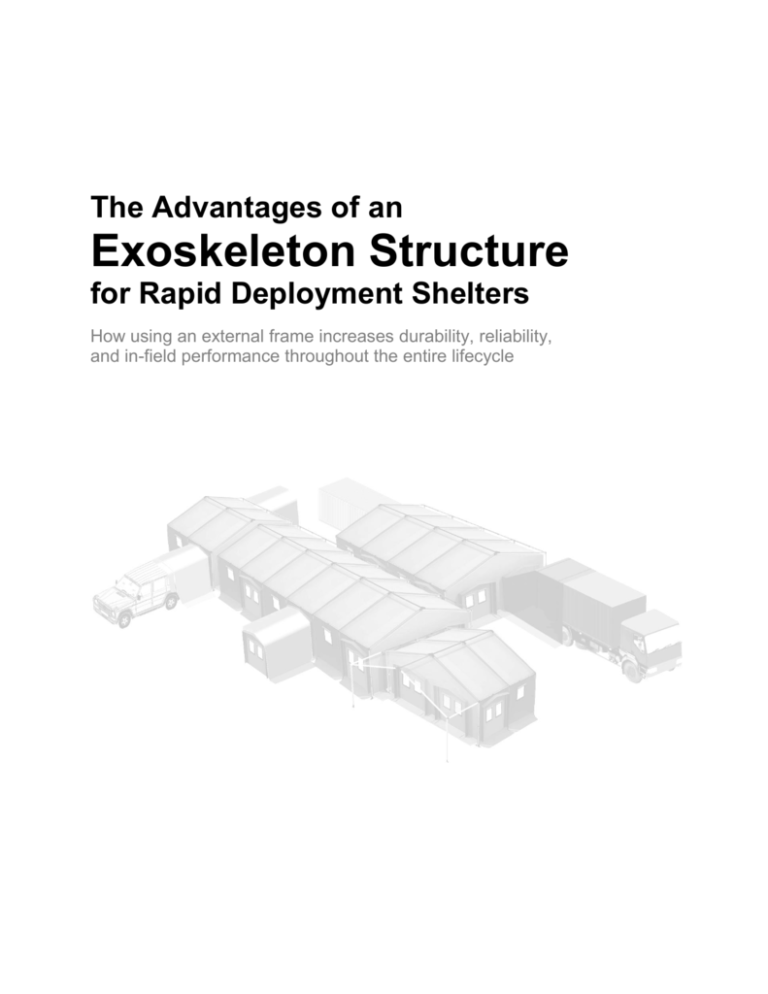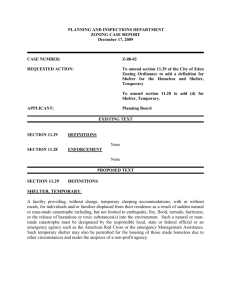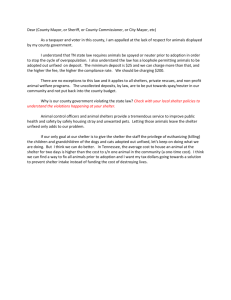Exoskeleton Structure
advertisement

The Advantages of an Exoskeleton Structure for Rapid Deployment Shelters How using an external frame increases durability, reliability, and in-field performance throughout the entire lifecycle Overview Rapid deployment shelter systems are crucial for incident response, crisis management, field hospitals, headquarter systems, early entry and tactical deployment. These fully-functional camp systems are often deployed in remote areas, and therefore, need to function autonomously with all of the necessary equipment and amenities available on location. Whether these portable camps are set up for temporary or semi-permanent use, they need to be durable and reliable in harsh climates and on a variety of terrains. High winds, heavy snow, rain, sand, and extreme temperatures – these structures need to stand up to demands similar to those of permanent buildings. However, quick set-up times and structural durability are just small pieces of the puzzle… The majority of shelters available on the market, are not designed to minimize the lifecycle maintenance times and costs – which represent the biggest challenge. Since most shelter systems are designed for temporary use, the lifecycle costs for shelter systems can be significant, and overall maintenance can be time-consuming. The typical lifecycle involves: • • • • • • • • Packaging and preparing for transportation Transportation to remote locations by land, sea, or air Locating the parts required to build the shelter system once on location, and receiving training for set-up and take-down Performing in-field maintenance without having to send it back to the company, and locating and isolating parts that need to be replaced due to accidental damage Cleaning, repairing, reconditioning, or decontaminating the canvas Reconfiguring the camp, as needed, to fit ever-changing needs such as additional accommodations, field hospitals, etc. Adding additional layers, as appropriate for the weather conditions Adding additional equipment to meet needs The Government of Canada has acknowledged that the standard ranges of deployable shelters on the market are not able to meet the requirements of the Canadian military. In April 2015, the Government put out a RFP to procure a Headquarter Shelter System (HQSS), which includes not only the shelters themselves, but the provision of spares, ancillary equipment, publications, training, field service support and In-Service Support for the HQSS. In order to meet this requirement, the shelter system must not only meet the structural requirements, but it must be designed to reduce logistical and operating costs, as well as reduce manpower and equipment needed. However, the commonly used internal-frame design does not achieve these requirements effectively. What Are the Advantages of an Exoskeleton Frame? Advantage 1 Reduced Maintenance and Lifecycle Costs The majority of the shelter systems available on the market expose the canvas to potential damage during set-up and daily use. Internal frames require the canvas to be pulled over the outside of the frame so that it rests on top of the frame, or to slide the frame inside pockets within the canvas to secure it in place. This increases the chances of ripping the canvas as it slides against the metal frame and can potentially get caught on the sections of the frame. Furthermore, during high winds, snow, or other loads, the frame rubs against the canvas, which increases wear and tear, and reduces the system’s life span. Reconditioning of the canvas presents a huge cost and challenge in typical shelter designs. Every time the canvas needs to be cleaned, repaired, or sanitized, you need to disassemble the entire structure to remove the canvas, because pulling the heavy canvas off the top of the frame exposes it to unnecessary pressure and adds additional risk through snagging and rippage. The exoskeleton structure reduces the possibility of damage to the canvas. The frame is set up first, and then an efficient pulley system lifts and secures the canvas in place. The exoskeleton principle allows the frame to be accurately pre-positioned and used to bear the full burden of the main canvas lifting and positioning process. This is achieved by unrolling and unfolding the canvas under the deployed frame, connecting the uphaul cords and using body weight to raise the canvas sections. An exoskeleton design protects the inner liner and significantly reduces maintenance by increasing duration between cleaning/refresh cycles by 30-50%. The external frame system allows for a fully integrated and sealed inner liner system, requiring no throughpenetration of structural members via wall, ceiling or floor membranes. This also significantly reduces the probability of damage to either membrane via holing, slicing or rippage of fabrics due to accidental contact during manhandling. Furthermore, the ability to offer a complete single-span open plan internal space with an integrated floor, prevents damage, soiling, discolouration and premature deterioration of the shelter interior. This can typically stretch the cleaning/refresh cycles of liners by an additional 30-50% compared with more traditional systems. Since the internal liner is suspended from the main canvas, it can be swapped, replaced or changed for an alternative liner extremely quickly and easily. This allows a single shelter system (frame and main canvas) to be quickly adapted and re-purposed for a multitude of roles. For example, allowing a medical shelter, and accommodation shelter to be formed from a single base shelter just by switching the internal liner. When the canvas of the exoskeleton structure needs to be reconditioned, it is as simple as lowering it with the pulley system, folding it up, and sending it back to the contractor. This saves a lot of time and effort, so that you can focus on the things that matter, and not on shelter maintenance. Advantage 2 Better Modularity and Flexibility of Camps Setting up a camp using a full shelter system can be challenging because all of the different “module” structures need to be pre-positioned in their proper place when starting to assemble the camp. Using a typical internal frame design, both the initial configuration and any changes made to the layout of the camp requires significant extra effort. These fully-functional camp systems need to function autonomously with all of the necessary equipment and amenities available on location. Modules typically include: Dormitories Medical post Washrooms Showers Conference room Refectory Storage Maintenance Offices Fire station Kitchen Shelters for aircrafts Water treatment stations Laundry room Incinerator Workshop Recreation area Camp protection Generator and power distribution units Fuel storage Electric network and local area network CBRN protection Using an exoskeleton frame provides a significant advantage for the modularity and flexibility of the camp. An exoskeleton allows for one common frame to be used for every single module, because the canvas is independent from the frame. You use the exact same frame, regardless of which module it is going to be used for. Since the canvas is attached from the inside, it makes it easy to swap, replace, or change it for another canvas. You can quickly adapt and re-purpose each structure based on current requirements by simply switching the internal liner without any changes to the base structure. For example, if you need to turn an office into an additional medical shelter, it’s as easy as lowering the standard canvas, and replacing it with a specialized medical canvas. The exoskeleton design allows for the commonality of components which provides you with the flexibility to meet your changing needs. Having the frame on the outside also makes it easier to position and connect corridors and airlocks between the individual shelters, as well as to add doors or connections to vehicles. Having standard doors with integrated connectors also means that the shelters can be connected in any configuration without the need for additional interfaces or linking units. And since all structures, connections, and doors in an exoskeleton shelter are standardized, it allows for significantly more configurations than are possible with an internal-frame shelter. Advantage 3 Reduced Logistics and Transportation Costs Logistics and transportation are a huge problem and cost when moving the shelters to a remote location by land, air, or sea. If the shelter has a large number of parts, they can get lost, and be hard to find or differentiate. Additionally, the weight is a big area of concern. When transporting a large number of shelters, the size and shape of the packaging can be crucial to reducing the total volume occupied. This is especially crucial when space is limited. An exoskeleton structure allows for a simplified design and commonality of components. It allows for the exact same frame to be used for any of the shelter modules. Additionally, the standardization of doors, connections, and frames makes it easy to unpack and find all of the pieces needed. The frame system is exactly the same for all the different sizes of the tent due to the modular approach: each tent is made up of two (2) identical end gable modules. Then intermediate modules can be added depending on the size of tent required. The exoskeleton frame also allows for a greatly reduced number of shelter parts, resulting in significantly fewer items which limits both losses and damage. It also allows for a more lightweight and compact structure, which significantly reduces logistic and transportation costs. Advantage 4 Simplified Set-Up and Maintenance Process The ability to quickly set up a shelter in the field is crucial. Not only does the set up need to be fast, but ideally, it should be very simple so that whoever is setting it up, doesn’t have to follow a complex set of instructions. A standard internal-frame shelter has many different parts, often requires additional equipment, and requires significant training beforehand. Also, during construction, you have to be extremely careful not to damage the canvas while the shelter is being set up. An external frame allows for a very simplified process without compromising the durability of the structure. Exoskeleton structures allow for a lower part count. With fewer items needed, and no tools other than manpower, the external frame allows for a simplified process to set up and maintain the structure. A streamlined design also means that field repair is much easier because of the ability to isolate, repair or replace parts. Standard shelter designs often require ladders and other equipment in order to complete the set up. However, the exoskeleton system lets you build the shelter first, then unfold the canvas and raise it using a pulley system to quickly position and align the canvas accurately, every time. This means that the shelter can be set up with as little as 2 to 4 people, with zero additional equipment and tools. The simplified design also makes it easier to set up with limited training and instructions. Since a common frame is used for all modules, the internal liner can easily be swapped, replaced or changed to meet your current requirements. Easily adjust to any terrain with stability that you can rely on. When setting up a camp, especially in a remote location, you will never have perfectly flat terrain to build on. These structures often have to be set up on uneven ground, rocks, grass, or even snow. Because the canvas and the frame of an exoskeleton are independent from each other, the frame can be assembled and pre-positioned in the most stable state – similar to how a camera tripod works. You can slightly adjust the position of each leg of the structure to ensure stability, even with solid flooring. This means that you don’t have to worry about what terrain the shelter will be set up on, because unlike an internal frame, the frame is capable of slight adjustments. In more extreme situations, it is possible to secure the frame with anchoring cables because the external frame allows for all-around access. The adjustability offers you considerably more options as to where to set up camp, regardless of the terrain. About Team Camec Team Camec has delivered over 25,000 shelters in the last 19 years for rapid response requirements. These soft walled shelters are in service in over 30 countries worldwide, and have been used on a number of projects for NATO countries. Team Camec's patent holder, Utilis SAS, is the largest shelter provider and the main provider to NATO for its deployable Headquarters Camp systems. Past and present projects include: NATO (NSPA) HQ Large Tented Camp and Accommodation CP156 2000 Man (2011 to present) DARS HQ Camp (NSPA) CP109 (2011 to present) NAMSA NRF Field Hospital ColPro System Spain Spanish Civil Guard – ColPro Decontamination System TMV12-20 for F16 Aircraft Maintenance French Armed Forces US Marines Deployable Accommodation/ HQ Facilities (2010 to 2013) Belgian Armed Forces APS15 for UAV Storage, Belgian Air force UK NHS Major Incident Decontamination Systems APS20 sunshield for protection of aircraft Proven Full Lifecycle Support We have supplied rapid deployment shelters around the world for key organizations involved in early entry and tactical deployments, incident response, crisis management, as well as other rapid response requirements. We have equipped a wide variety of camps, both large and small, which incorporate all functional amenities. Our versatile product line and high level of expertise allows us to deliver an extraordinarily wide range of capabilities, including accommodations, field hospitals and medical facilities, headquarter systems, CBRN Collective Protection enabled complexes, and all associated support equipment and furnishings. We understand that the military needs more than “just a shelter”, because it is the lifecycle support that poses the biggest challenge in terms of time, cost, and risk. We have developed a proven system that includes a core infrastructure and supporting deliverables capable of achieving high levels of autonomous operational availability. Fully Manufactured in Canada to Support the Canadian Economy Team Camec was formed in response to a current Government of Canada tender to procure Headquarter Shelter Systems, and to comply with the Defence Procurement Strategy (DPS) objective to leverage purchases of defence equipment to create jobs and economic growth in Canada. We deliver a high-quality product that is fully manufactured and supported in Canada in order to support the Canadian economy through business, research, and export opportunities. Our tried-and-tested structures provide lower lifecycle costs and improved performance. Team Camec is a partnership between Camec, Utilis SAS, Promaxis and Tulmar: Promaxis operating in the manpower services and defence support area for the Canadian Government, Tulmar designing, manufacturing and performing ISS on shelters/life support equipment for the Canadian Department of National Defence (DND) and Utilis SAS designing and manufacturing soft-walled shelters which are in service in over 30 countries worldwide. Team Camec has created a global alliance to address the ever-increasing need for asset management and support in the defence sector. Each organization brings a crucial and versatile skill set to the alliance, but also the significant crossover of experience leverages expertise in order to provide high-quality shelter systems that meet and exceed the requirements of DND. Team Camec’s Shelter Systems Team Camec’s rapid deployable tactical soft-wall shelters are the most advanced design on the market today, with a patented folding-frame design that has been tried and tested in some of the harshest climates around the world for almost 20 years. These rapid deployment shelters were introduced to the U.S. Army in 2005, and have gained recognition as a major military shelter due to its incredibly simple but durable design, fast set up time and lightweight features. Our innovative shelters are optimized to reduce logistical and operating costs, reduce manpower, and provide significant energy savings. And the shelters are truly multi-functional: the single frame design fits all of the module internal liners, so that the canvas can be easily swapped and re-purposed without the need for a new frame. The shelters are available in a wide range of sizes and configurations. Each of these shelters is designed as an individual module, which allows for an unlimited amount of configurations. This means that the structures can be tailored to your specific requirements, whether you require short term or long-term camp solutions. The shelters have a wide range of options and ancillary items available, including internal partitions types, standard lighting and power distribution sets, accommodation packs, a range of overhead cable and equipment fixing solutions, hard and soft door options and deployable flooring and camp furniture solutions. These tents have been used on a number of commercial activities including arctic region exploration where they have had to withstand sustained extreme low temperatures and high wind conditions. The shelters have been used for a multitude of different capabilities, including: • • • • • • Camp accommodation systems. Decontamination units. Command posts and camps. NBC and COLPRO protection. Mobile field hospitals and first aid facilities. Maintenance/protection facilities. Set up in as little as Only requires 3 minutes. manpower of Step 1 Assemble the first side of the frame Step 2 Attach cables to the frame Step 3 Attach frame legs on the other side Step 4 The lightweight, foldable frame system is proven to withstand snow loads up to 98kg/m2 and for wind speeds of 110km/hour; both of which exceed the requirements of the Canadian military. We have developed proven layouts for the system as well as key parameters such as the thermal value (U factor at 1.1 W/M2/C°, 0.9R in SI units, or 5.4R in imperial unit) up to 4 times better than most standard shelters. The shelters have been designed for a wide range of temperatures, as well as conditions which could include high winds, snow, humidity, etc. Camec has carefully selected, tested, and integrated specialized materials and technologies within the existing range of products to tailor the shelters to the specific needs of the Canadian military. Use pulleys to do heavylifting of the canvas Step 5 Finish in as little as 3 minutes 2 to 4 people








